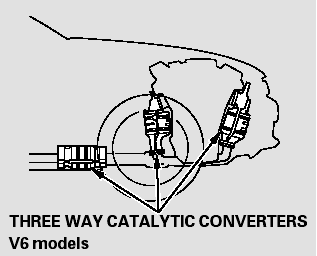 Honda Accord: ThreeWay Catalytic Converters
Honda Accord: ThreeWay Catalytic Converters
The three way catalytic converters contain precious metals that serve as catalysts, promoting chemical reactions to convert the exhaust gasses without affecting the metals.
The catalytic converters are referred to as three-way catalysts, since they act on HC, CO, and NOx.
Replacement units must be original Honda parts or their equivalent.
The three way catalytic converters must operate at a high temperature for the chemical reactions to take place. They can set on fire any combustible materials that come near them. Park your vehicle away from high grass, dry leaves, or other flammables.

Defective three way catalytic converters contribute to air pollution, and can impair your engine’s performance. Follow these guidelines to protect your vehicle’s three way catalytic converters.
Always use unleaded gasoline.
Even a small amount of leaded gasoline can contaminate the catalyst metals, making the three way catalytic converters ineffective.

Keep the engine well maintained.
Have your vehicle diagnosed and repaired if it is misfiring, backfiring, stalling, or otherwise not running properly.
 Emissions Controls
Emissions Controls
The burning of gasoline in your
vehicle’s engine produces several byproducts.
Some of these are carbon
monoxide (CO), oxides of nitrogen
(NOx), and hydrocarbons (HC).
Gasoline evaporating fr ...
 Emissions Testing
Emissions Testing
Testing of Readiness Codes
If you take your vehicle for an
emissions test shortly after the
battery has been disconnected or
gone dead, it may not pass the test.
This is because of certain ‘ ...
See also:
Trunk Lid Weatherstrip Replacement
NOTE: 4-door Is shown; 2-door Is similar.
1. Remove the trunk lid weatherstrip (A) by pulling it off.
2. Locate the painted alignment mark (B or C) on the
trunk lid weatherstrip. Align the pain ...
Clutch Interlock Switch
Replacement
M/T model
1, Disconnect the clutch interlock switch connector (A).
2. Loosen the locknut (B), then remove the clutch
interlock switch (C).
3. Install the clutch interlock switch, and adjust th ...
